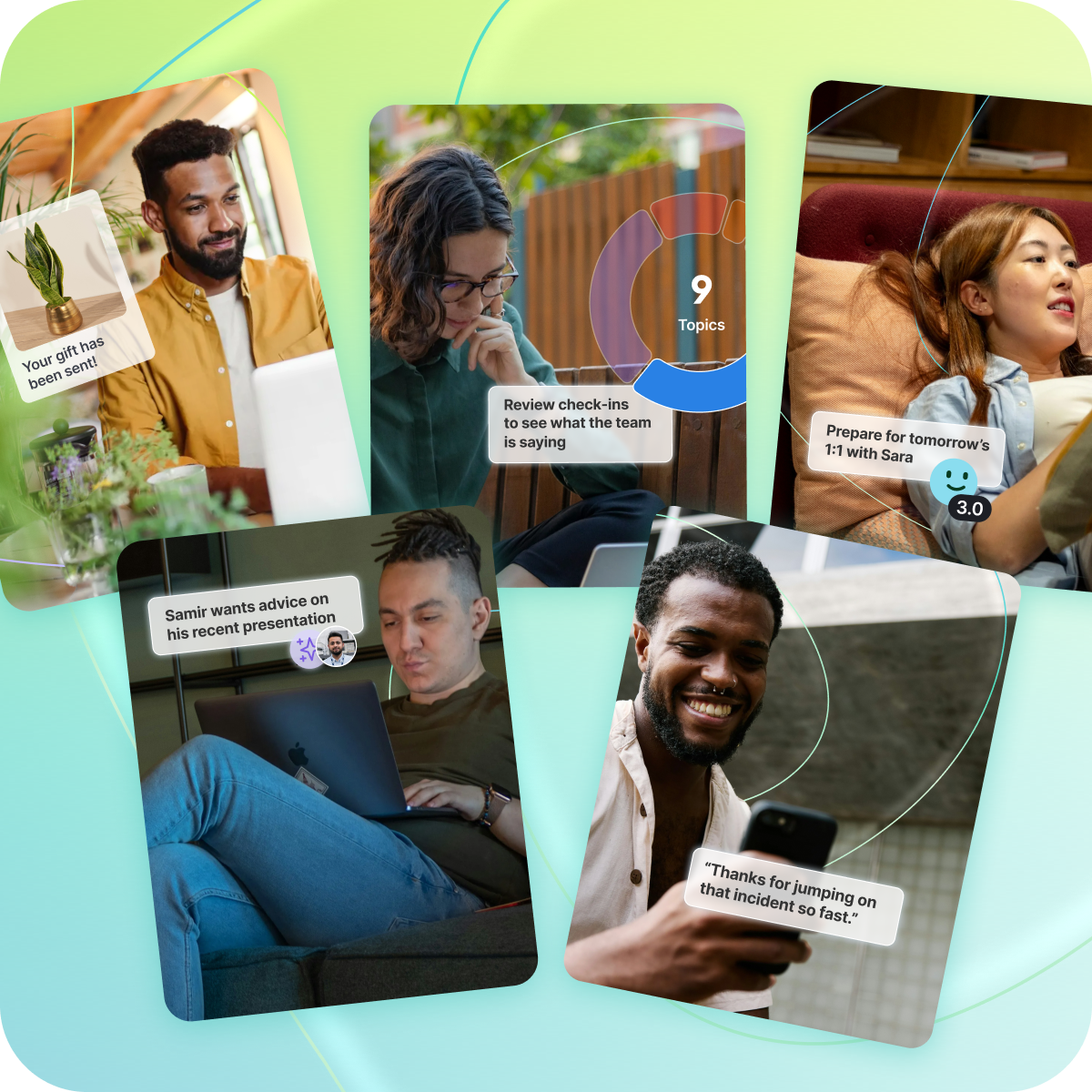Employee Engagement vs. Employee Experience

As employee wellbeing and retention climbed to the top of many companies’ focus areas in the past few years (hello, tight labor market!), buzzwords like employee experience and employee engagement have been flying around, often interchangeably.
But those two important terms have different meanings—and the differences are vital to understanding if you want to create a better environment for your employees.
So what do you need to know about employee experience vs. employee engagement? And how should you improve and measure your improvements in both areas? We’ve got your complete guide for HR pros who want to put their people first.
What is employee experience?
Since employee experience is a broader topic, let’s tackle this one first. Employee experience is the complete journey that an employee takes with your company, from the moment they hear about an open position through hiring and onboarding onto their full career at your organization.
Employee experience is how your people interact with your brand: are you living up to your brand promises as an employer? Or are you falling short by putting employee needs to the side, either because it’s not convenient or because you’re stuck doing things the way your organization has always done them?
One critical thing to note about employee experience is that this is where the employer has control and influence. Employee experience covers things like the office where your people work, the policies that let them work flexibly, the compensation and benefits you offer, and the onboarding you direct new employees through.
A great employee experience spans the whole employee lifecycle, and requires thinking carefully about each employee touchpoint to optimize them for your people. Even seemingly small touchpoints can have a major impact on the employee experience, like giving remote and hybrid employees a stipend to set up their home offices ergonomically and comfortably or offering healthy snacks in the break room.
Employee experience is about feeling cared for and valued, and there are so many ways to improve it:
- Creating a culture of respect
- Effectively onboarding new employees
- Holding regular team-building exercises
- Generally improving your company culture so your workplace is a more positive place to be
--> Anything that improves your overall culture and how employees experience their workplace (both physically and emotionally) will boost your employee experience. Check to see how your culture stacks up with our new company culture quiz!

What is employee engagement?
Employee engagement, on the other hand, is how employees connect with the work they do, the purpose of your organization, and the people around them. You can’t increase engagement by upgrading your office or holding a single team-building exercise—engagement comes from finding meaning and value in your work.
Engagement can be harder for organizations to address because employers can’t directly deliver engagement like they can a better experience. You must provide employees with opportunities for growth, meaningful work towards a mission, and plenty of autonomy, and let them take it from there.
Employee engagement is about feeling recognized, connected, and positively challenged to grow, and there are also so many ways to improve it that also boost your employee experience:
- Building a culture of recognition
- Increasing transparency in your organization
- Creating stronger connections between employees
- Breaking down organizational silos to make working across functions easier
Anything that helps employees connect more to the purpose of your organization and their colleagues and leaders, and do their best work towards that purpose, will boost your employee engagement.
--> See how Bonusly elevates employee engagement at Rechat
How employee experience and engagement connect
Employee engagement and employee experience are not the same thing, as we’ve just seen—but they are deeply interconnected in several ways.
First, it’s hard to have an engaged employee base if your employee experience is poor. (It’s not impossible, if your people are truly committed to your mission to do good in the world or your community like in a nonprofit or healthcare, but it’s a whole lot harder.)
A good employee experience is the baseline of employee engagement. It’s much easier to feel engaged if you have a comfortable working environment and everything you need to get your job done.
But engagement goes above and beyond that employee experience. You can have a terrific employee experience with all the perks and benefits an employee could dream of, but if they’re overworked, lacking autonomy, and don’t see a path to progress, they’re going to be disengaged—and they’re also likely going to leave.

How to measure employee experience and engagement
You should be measuring both engagement and employee experience regularly to see how your organization stacks up—you can’t improve what you don’t measure! And a great way to measure both is to simply talk to your teams. Employee surveys is a great way to do this.
An annual employee opinion survey is a great start if you’re not already conducting one. But you should also add in pulse surveys throughout the year—only measuring once per year makes your progress much slower.
Questions to include about employee experience may include:
- What three words would you use to describe [company]?
- Do you feel like you belong at [company]?
- What do you like most about [company’s] culture?
- What do you like least about [company’s] culture?
- Do you have a clear understanding of what is expected of you in your current role?
- Do you have the materials and equipment you need to do your job well?
Questions to include about employee engagement:
- How satisfied are you at [company]?
- Do you feel you’re able to have a positive work-life balance?
- Have you received recognition or appreciation for your work in the last seven days?
- How much autonomy or decision-making power do you have in your job?
- Do you feel able to grow and develop your career at [company]?
- Have you and your manager discussed learning and development opportunities?
And with all surveys, don’t forget the most important part: actually acting on the feedback you received, and telling employees how you did it! If employees keep spending their valuable time responding to your surveys, sharing their opinions and thoughts, and nothing significant ever changes in their experience at your company, that’s frustrating. It can be frustrating enough to actually lower engagement—because they feel ignored and unseen.
And yes, sometimes acting on this feedback can be challenging, especially regarding engagement. It’s tempting to just address the surface issues and hope that your shiny new software or internal branding solves everything, but it’s not realistic. Putting in the difficult work to create a truly engaging environment for employees pays off: highly engaged organizations have 23% higher profitability and 18% higher productivity, among many, many other benefits.

The takeaway
Employee experience and employee engagement are two different, but deeply entwined, components of any successful workplace. Understanding their differences gives you a greater sense of how they work together to create a company where employees love to spend time, do their best work, and stay to build their careers. And that’s the foundation of a thriving company.
Looking for more ways to build a company culture where employees perform at their best every day and become a magnet for top talent? Bonusly's employee engagement software can help—check out our solutions for HR leaders like you and schedule a demo.
.webp)







